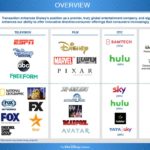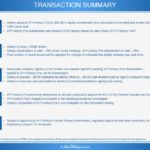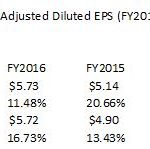Contents
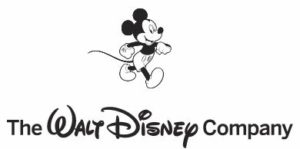 Summary
Summary
- DIS has offered to acquire certain 21st Century Fox, Inc. assets for $52B to help it expand into the direct-to-consumer streaming distribution business.
- The stock is attractively valued based on forward EPS and free cash flow.
- Despite the attractive valuation, I have several reasons why I will not initiate a position in DIS at this juncture.
Introduction
Investing in high quality companies with a sustainable competitive advantage has proven to be fruitful for me. The companies in which I have invested to date are, for the most part, companies in which I am comfortable holding for the very long-term. As a result, I typically try to add to our existing positions. I do, however, keep an eye open for opportunities to expand the names in my portfolio bearing in mind that I want to avoid a common practice of acquiring a few shares in a plethora of companies (aka ‘throwing mud at the wall’).
A reader recently reached out to me inquiring whether I had an opinion on The Walt Disney Company (NASDAQ: DIS). As I had never reviewed DIS I thought this would be an opportune time especially since it has offered to acquire specific Twenty-First Century Fox, Inc. assets for $52B!
Media Landscape
The media landscape has changed considerably over the years. In the past there were studios which created content and sold it to television distributors who then sold it to consumers. The media industry, however, has evolved to the extent where distributors acquire content from studios and create their own content which they subsequently sell directly to consumers.
A perfect example of this is Netflix (NASDAQ: NFLX). In addition, you have tech giants like Alphabet (NASDAQ: GOOG), Amazon (NASDAQ: AMZN) and Apple (NASDAQ: AAPL) who are getting in the game. This explains why older media companies such as CBS (NYSE: CBS) and Viacom (NASDAQ: VIA) want to merge and why AT&T (NYSE: T) wants to acquire Time Warner (NYSE: TWX).
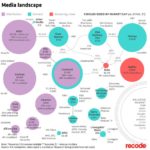 Source: Recode
Source: Recode
Business Overview
DIS emphasizes the value of high-quality, branded entertainment. Examples of this are reflected in DIS’s acquisitions of Pixar, Marvel, and Lucasfilm/Star Wars.
DIS, together with its subsidiaries, is a diversified worldwide entertainment company with operations in four business segments:
- Media Networks – includes cable and broadcast television networks, television production and distribution operations, domestic television stations and radio networks and stations.
- Parks and Resorts – Walt Disney World Resort in Florida; the Disneyland Resort in California; Disneyland Paris; Aulani, a Disney Resort & Spa in Hawaii; the Disney Vacation Club; the Disney Cruise Line; and Adventures by Disney. DIS manages and has effective ownership interests of 47% in Hong Kong Disneyland Resort and 43% in Shanghai Disney Resort.
- Studio Entertainment – produces and acquires live-action and animated motion pictures, direct-to-video content, musical recordings and live stage plays.
- Consumer Products & Interactive Media – licenses DIS’s trade names, characters and visual and literary properties to various manufacturers, game developers, publishers and retailers throughout the world. It is also engaged the development and publishing of games, primarily for mobile platforms, and books, magazines and comic books. Branded merchandise is distributed directly through retail, online and wholesale businesses. This segment’s operations include website management and design, primarily for other Company businesses, and the development and distribution of online video content.
The magnitude of DIS’s extensive operations cannot possibly be covered in this article. I, therefore, highly recommend that anyone interested in obtaining a better understanding of DIS’s overall operations turn to Part 1 of the 2017 Annual Report.
Its strategy is to continue to invest in entertainment, particularly in a world that seems to be growing in terms of its appetite to consume entertainment.
In addition, DIS recognizes the marketplace is dynamic. As part of its strategy it recognizes it needs to not only have more product (intellectual property) but it must also bring its product to consumers in more compelling ways.
DIS is also focused on growing globally. While it has had a global presence for many years, its presence in many markets has been relatively superficial. An example of some of the advances DIS has made internationally over the past decade includes Shanghai Disneyland in China.
Acquisition of Specific Twenty-First Century Fox, Inc. Assets
DIS’s December 14, 2017 announcement of its intent to acquire certain 21st Century Fox, Inc. (‘21CF’) assets can be found here. Unfortunately, U.S. cable company Comcast Corp’s recent offer to acquire Sky Plc for $31B raises the specter of a potential bidding war between Rupert Murdoch’s Twenty First Century Fox and DIS. An interesting video on this matter can be viewed here.
Investors will need to monitor the situation closely to see how this all plays out. In the interim, the following is the rationale for the offer as well as a high level overview of the financial terms of the offer.
The rationale for DIS’s ambitious acquisition of 21CF is that more cable networks, production studios and other properties will help it in its efforts to expand into the direct-to-consumer streaming distribution business; the plan is to launch sports and entertainment services in 2018 and 2019, respectively.
Source: DIS – 21st Century Fox Transaction Announcement December 14, 2017
NOTE: 21CF is one of two companies formed from the 2013 spin-off of the publishing assets of News Corporation and is currently the 4th largest media conglomerate after DIS, Comcast and Time Warner in the US.
Through the acquisition of 21CF, DIS sees the FX, National Geographic, Marvel, and Avatar franchises are being an ideal fit with the high-quality branded content already in DIS’s portfolio.
DIS has offered ~$52.4B (purchase price of $66.1B which includes $13.7B in Fox debt) in an all-stock transaction for:
- 20th Century Fox film studio;
- a cable group that includes FX Networks, National Geographic and 300-plus international channels, and 22 regional sports networks;
- Fox’s 30% stake in Hulu;
- a 50% share of Endemol Shine Group, the Star India satellite service;
- Fox’s 39% interest in Euro satellite broadcaster Sky.
The assets DIS will not be acquiring consist of the Fox television network, Fox News Channel, and most of Fox Sports as these assets will be spun off into an independent company run by the Murdoch family.
Source: DIS – 21st Century Fox Transaction Announcement December 14, 2017
Prior to Comcast entering into the fray DIS indicated it expected the regulatory review of the acquisition to be approved and to close within 12 to 18 months of the December 2017 deal announcement. Should DIS succeed with its offer, it is confident it will be able to generate $2B in cost savings from combining DIS’s and Fox’s overlapping businesses by 2021.
The merger agreement is scheduled to terminate on December 13, 2018 unless it is extended. The break-up fees are mutual in that DIS or Fox will pay the other a fee of $1.525B if it backs out of the deal and DIS will also pay Fox a $2.5B break-up fee if it fails to gain the necessary regulatory approvals.
I note that the U.S. Department of Justice (DOJ) has taken a hard line in trying to block the AT&T/Time Warner merger and I wonder whether it will do the same on the 21CF deal. The fact that the Fox acquisition by DIS is a traditional horizontal merger means an industry competitor will be eliminated. As such, if the DOJ does not block the deal altogether, I suspect a DOJ approval would come with the condition that DIS sell off valued assets.
Initiatives
Over the Top (OTT)
While the 21CF acquisition is receiving most of the limelight, DIS believes there is huge growth potential in certain markets on the media front. DIS has specifically stated it wants to participate in the new OTT market. At the moment it is only doing this with Hulu in which it holds a 30% stake. If the 21CF acquisition succeeds, DIS will have a controlling stake.
The manner in which consumers want to access media has also changed dramatically. In many cases, consumers want to be able to access content via mobile applications first. As such, the user interface is particularly critical…especially for millennials and younger, where the user interface that exists in the traditional television platform is not as compelling to them.
ESPN
DIS will be launching a brand new app for ESPN at the end of March or early April. This app will continue to provide users with scores and highlights but in a more compelling manner.
- the quality of the video will be superior;
- substantial levels of personalization and customization will be added;
- an augmented product (ESPN+) will be added which will have about 10,000 additional sports and will work on smartphones, tablets, and on smart TVs.
Disney
Later in 2019, DIS will have the output of its Studio available in the so-called Pay window exclusively on the DIS platform. It will also have ~ 5,000 episodes of Disney-branded television. There is also talk about a Marvel series, a Star Wars series, and a Disney-branded series (eg. High School Musical) being made direct to the consumer. The Studio will also have an Avengers movie, Toy Story 4, The Lion King, Frozen, Aladdin, and Dumbo.
With respect to competing with NFLX, DIS views itself as a completely different business. It views NFLX as a very high volume business whereas DIS is in the business of less volume but more branded product.
BAMTech
BAMTech is DIS’s tech hub; DIS owns 75%. This entity has the technology to stream under high-quality circumstances and volume as well as the ability to serve advertisers with dynamic ad insertion. BAMTech can then gather and analyze the necessary data to offer personalization and customization.
Impact of the Tax Cuts and Jobs Act (TCJ) on DIS
In Q1 2018 DIS’s effective income tax rate was a 19.4% benefit versus a 33.2% income tax expense for Q1 2017. The 52.6% change in DIS’s effective tax rate reflected two significant impacts of the TCJ.
- a one-time net benefit of approximately $1.6B, which reflected an approximate $1.9B benefit from remeasuring the deferred tax balances to the new statutory rate. This was partially offset by a charge of ~$0.3B from accruing a deemed repatriation tax. These figures had a net benefit of ~41.8% on the effective income tax rate.
- a reduction in the fiscal 2018 U.S. statutory federal income tax rate to 24.5% versus 35.0% in the prior year. Net of state tax and other effects, the reduction in the statutory rate had an impact of ~9.2% on the effective income tax rate.
Q1 2018 Results
DIS’s February 6, 2018 Earnings Release can be found here.
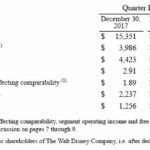 Credit Ratings
Credit Ratings
At the time of the acquisition announcement, DIS indicated it is committed to a strong balance sheet and strong investment grade ratings.
Moody’s currently rates DIS’s senior unsecured debt A2; this rating was reaffirmed in December 2017 after the acquisition announcement. S&P Global, however, rates DIS’s local currency long-term debt as A+ and has this rating under review with negative implications.
Moody’s rating is at the mid-point of the upper medium grade range while S&P’s rating is currently at the top end of the upper medium grade range. I suspect S&P Global will lower DIS’s rating by one notch before the acquisition is completed thus resulting in both ratings agencies according a similar mid-point of the upper medium grade range rating.
Free Cash Flow (FCF)
‘Revenue is vanity. Profits are sanity. Cash is reality.’ This explains why FCF is a key metric upon I which I rely as part of my analysis; it cannot be easily manipulated with one-time charges or events as in the case of earnings.
I generally look for FCF/Revenue in excess of 10% as this level provides me with some comfort the company is generating sufficient cash flow. Looking at the following analysis, DIS has exceeded my 10% threshold for the last few years. The Q1 2018 level is before 10% but I do not place much emphasis on this metric on a quarterly basis.
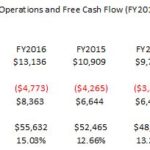 Valuation
Valuation
I have been unable to locate any management estimates after the 21CF announcement as to what it anticipates will be 2018 EPS. The most current estimate I can find a consensus diluted EPS forecast of ~$6.95 from multiple analysts. The difficulty I have with this consensus estimate is that the high estimate is ~$7.20 and the low estimate is $6.65; this is a very wide disparity. On the basis of FY2017 $5.69 diluted EPS, the ~$6.95 represents a ~22% increase. This certainly is a dramatic increase but DIS has achieved this growth level in some of the previous years.
Looking at the current DIS (without 21CF), DIS is trading at $104.73 as at the close of business March 9, 2018 thus giving us a forward PE of ~15 based on diluted EPS of $6.95. This level is below the upper teens and lower twenties evidenced 2013 – 2017.
Dividend, Dividend Yield, and Dividend Payout Ratio
DIS is certainly not a company that would appeal to dividend yield hungry investors. Based on the $104.73 price and the most recent $0.84 semi-annual dividend which was paid January 11, 2018, we get a ~1.6% dividend yield.
Secondly, I have been unable to easily find historical dividend information and had to resort to this site.
Thirdly, DIS used to pay an annual dividend but in 2015 DIS transitioned to a semi-annual dividend. Most investors seeking dividend income expect at least a quarterly dividend.
I am not a dividend yield chaser nor do I need to see a quarterly dividend payment. In fact, if a company can generate a better return for shareholders by retaining earnings, then I have no objection to investing in the company. In fact, when a company pays me a dividend I get taxed. If the company can repurchase shares or grow the business with retained earnings then hopefully the stock price will appreciate in value; I don’t incur any tax until I sell my position which is typically many years into the future.
On the November 9, 2017 FYE2017 conference call, management indicated it expected to repurchase $6B in stock, an amount similar to what it had repurchased on average over the past 5 years. Given DIS’s subsequent offer to acquire 21CF, this is no longer the case. Investors can expect share count to increase but at this juncture it is premature to tell to what extent.
Final Thoughts
There is no denying DIS is a high quality company worthy of being held in a well diversified portfolio. While I agree it is currently attractively priced, I just cannot bring myself to initiate a position in DIS at the moment. My reasons are as follows:
While DIS has offered $52B for 21CF, this purchase price could change dramatically given that Comcast has entered the picture. Without knowing the final price for 21CF it is too difficult for me to make a fully informed decision.
I have not seen any forecast from DIS’s management as to what it expects in the form of FCF or EPS if the 21CF transaction closes.
The DOJ will undoubtedly get involved. What DIS intends to acquire may certainly be impacted if the DOJ grants its approval of the acquisition. If the DOJ does not grant approval, DIS will be required to pay Fox a $2.5B break-up fee and will receive nothing in return.
If we enter an economic downturn in 2019 – 2020 (just after DIS expects the acquisition to close), this would likely result in a drop in consumer confidence/spending which would negatively impact businesses across DIS’s portfolio. While DIS could certainly introduce discounted pricing to stimulate revenue, this would negatively impact profitability.
Disney has increased its economic sensitivity through the reacquisition of Disney retail stores in North America and Japan. A drop in consumer confidence/spending would also hit this area of DIS’s business.
DIS is experiencing considerable success with its Black Panther release. The Studio Entertainment and Media Networks divisions, however, depend on advertising spending as a major component of revenue. This makes revenue highly sensitive to cyclical fluctuations. These divisions must deal with the hit-or-miss nature of the media business and are challenged in their efforts to control the high costs of producing professional branded entertainment content.
Given the reasons noted above, I will move on to seek other investment opportunities.
Thanks for reading!
Note: I sincerely appreciate the time you took to read this article. Please send any feedback, corrections, or questions to charles@financialfreedomisajourney.com
Disclaimer: I have no knowledge of your individual circumstances and am not providing individualized advice or recommendations. I encourage you not to make any investment decision without conducting your own research and due diligence. You should also consult your financial advisor about your specific situation.
Disclosure: I do not currently hold a position in DIS and do not intend to initiate a position within the next 72 hours.
I wrote this article myself and it expresses my own opinions. I am not receiving compensation for it and have no business relationship with any company whose stock is mentioned in this article.



